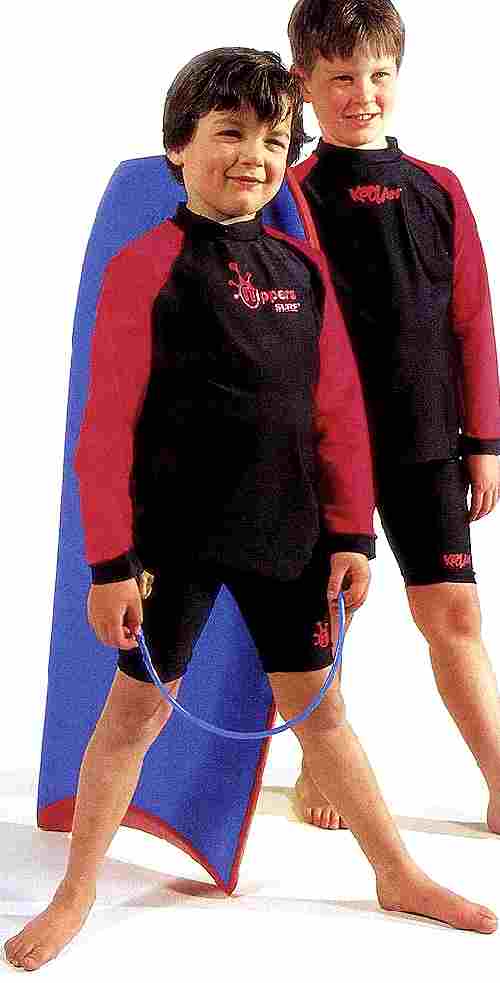
Figure 1.--These Australian boys wear matching long sleeve rash shirts and Lycra bike shorts as beachwear in an advertisment dated about 1995.


Figure 1.--These Australian boys wear matching long sleeve rash shirts and Lycra bike shorts as beachwear in an advertisment dated about 1995. |
Lycra is a sunthetic fabric which was riginally developed as a replacement for rubber, LYCRAŽ is remarkable for its ability to stretch up to six times its original length--and then amazingly snap back to its starting size with no loss to its spring. Every day in every country, LYCRAŽ lends those properties to every fabric and garment in which it's used. A touch of LYCRAŽ is the solution, adding comfort and freedom of movement and improving the fit, shape retention, drape and wrinkle resistance of the apparel. It has proven to be especially useful in bike shorts and sunsuits, perhaps more popular in Australia
than many other countries.
Lycra was developed as a replacement for rubber.
DuPont in 1958 invents "Fiber K", the fiber soon to be trademarked as LYCRAŽ. LYCRAŽ in 1959 is first used in the intimate apparel category. LYCRAŽ in 1962 is used in support hose. LYCRAŽ in 1968 is used in ski-wear by the medal-winning French ski team. Pantyhose
manufacturers begin using the fiber in 1970. Control top pantyhose with the miracle fiber are introduced in 1972. LYCRAŽ first makes a splash in the swimwear in 1974. market. Sheer pantyhose with LYCRAŽ are introduced in 1979. Michael Jordan and other NBA stars in 1985 begin wearing compression shorts with LYCRAŽ. A technical renaissance
begins for LYCRAŽ as state of the art spinning equipment in 1889 allows for new innovations and products. The 1991 Penn State study on the athletic benefits of LYCRAŽ begins, as the new LYCRAŽ logo is introduced to the public. People everywhere in 1994 begin to rediscover the smooth, sleek line of bodyshapers with
LYCRAŽ. Plus, LYCRAŽ 3D demonstrates the fiber's
power to stretch across dimensions, adding
revolutionary three-dimensional comfort to hosiery and
leggings. Let the games begin! LYCRAŽ Power
compression shorts become available in 1996, helping reduce athletes' muscle fatigue and increasing their
endurance. The popularity of menswear
with LYCRAŽ is on the rise, with even President Clinton sporting a suit made with the fantastic fiber. Millions of
LYCRAŽ Power shorts in 1998 are shipped to stores in the U.S. And the fiber makes great strides as leather shoes with
LYCRAŽ hit the sidewalks.
LYCRAŽ is remarkable for its ability to stretch up to 6 times its
original length--and then snap back to its starting size with no loss to its spring. Every day in every country, LYCRAŽ lends those properties to every fabric and garment in which it's used. A touch of LYCRAŽ is the solution, adding comfort and freedom of movement and improving the fit, shape retention, drape and wrinkle resistance of the apparel.
Lycra is never used byitself, but rather is blended with other fabrics. There is really no such thing as a commercially available fabric made entirely of LYCRAŽ. You might think of it as a social fiber: it's never used alone, but is always combined with another fiber (or fibers), both natural or man-made. As little as 2 percentLYCRAŽ is enough to improve a woven fabric's movement, drape, and it's knack for
holding its shape. Whatever the blend, fabrics enhanced with
LYCRAŽ keep the look and feel of the majority fiber.
LYCRAŽ is a man-made elastomeric fiber, invented and produced only by DuPont. Generically, these kind of fibers are known as spandex in the US and Canada and as elastane in Europe.
LYCRAŽ is a "segmented polyurethane." While LYCRAŽ appears to be a single, continuous thread, it is actually a bundle of tiny filaments. It's this unique molecular structure that gives LYCRAŽ its built-in, lasting elasticity. Stretch it four to seven times its original length, yet the fiber still returns to its starting size once the tension is released.

Figure 2.--This boy wears a short sleeve rash shirt and Lycra bike shorts set as beachwear in advertisment appearing about 1998. |
While firrst development for women's intimate apparel, garments with Lycra have become best known for atletic and leasure wear.
Some fashion magazines started promoting boys bike shorts as summer wear in 1988, but they did not become really popular until summer 1989. Boys bike shorts went out of
mainstream fahsion about 1993 when big baggy shorts became the rage. Skatboarders liked baggies, probably because they were older boys and didn't like the form fitting style of the
bike shorts. They also followed African-American culture closer, where bike shorts have never been popular.
Some sun protection wear makers make the sunsuit, wich is bike shorts and rashie combined in one suit, and has a zipper like a springsuit up the back or sometimes up the front and made of lycra instead of wetsuit rubber. Sometimes you see the long sleeve
sunsuit, which has long sleeves and short legs, and sometimes you see kids wearing the sunsuit that looks like a steamer with long sleeves and long legs. These normally have the zipper up the back with a piece of string to grab hold of it. Some kids wear their speedos underneath there sunsuits, but most dont bother , just wearing the sunsuit as a swimming costume. Kids who dont want to wear the sunsuit wear a rashie. With the rashie they wear speedos, boardies or bike shorts, or with a long sleeve rashie some boys will even wear footless lycra tights or
leggings. Sunsiuts are normally brightly colored, or with big panels of dark color or black and small areas of neon color. The most popular colors are black or dark blue with some neon blue, yellow or red. Girls
wear sunsuits as well as boys do, and they tend to be bright pink a lot.
Navigate the Boys' Historical Clothing Web Site:
[Return to the Main material page]
[Introduction]
[Chronology]
[Clothing styles]
[Biographies]
[Bibliographies]
[Contributions]
[Activities]
[Countries]
[Boys' Clothing Home]
Navigate the Historic Boys' Clothing Web chronological pages:
[The 1840s]
[The 1900s]
[The 1930s]
[The 1940s]
[The 1950s]
[The 1960s]
[The 1970s]
[The 1980s]
[The 1990s]
[The 2000s]
